The Beginner's Guide To Catching HUGE Largemouth Bass!
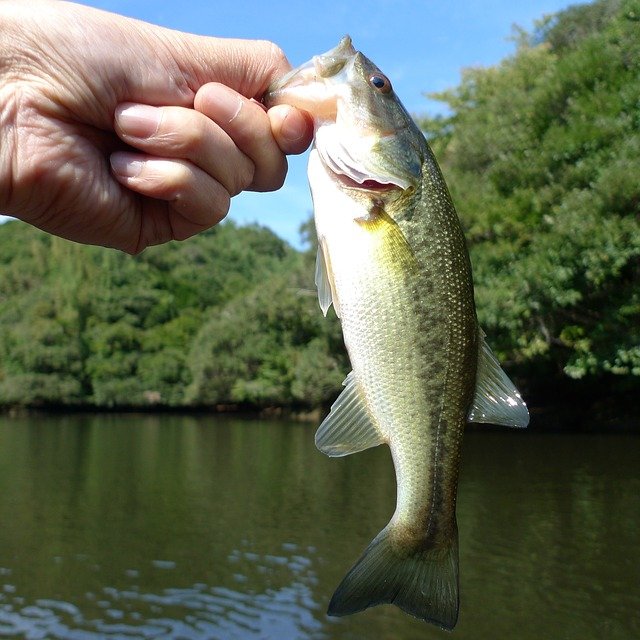
Largemouth bass fishing is one of the most exhilarating and popular freshwater fishing sports in North America. Many fisherman, pros and novices alike, search for the rush of hooking an elusive largemouth bass. Bass are known to be hard biters and strong fighters, and amongst the smartest of freshwater fish. They can be picky about what they eat and often change locations, but with a little knowledge and some good old fashioned luck, you can easily hook a huge lunker.
I have been fishing for bass for more than 20 years, so I figure it's time I shared some of my knowledge and experience. I have learned a lot about how to catch largemouth bass throughout the years, and one thing I learned right away is that these fish aren't dumb. It takes skill and finesse to catch a bass, but it's a truly rewarding experience. After reading this article, you should definitely be able to go out and hook yourself a fightin' largemouth bass!
Tools Of The Trade
Before you get out on the lake, you're going to need the proper equipment. It won't be expensive, but it will be important that you pick up the right things if you want to catch largemouth bass. Before you buy any equipment, however, you should purchase the proper fishing license. Never, ever, fish without a fishing license. In most states, the only time you can fish without a license is if you are under the age of 14 or over 70, or if you are fishing on private property. You can pick up a license at just about any large sporting good store. They can cost anywhere from $5-$50, depending on where you live. Now that you've got that out of the way, it's time to go shopping.
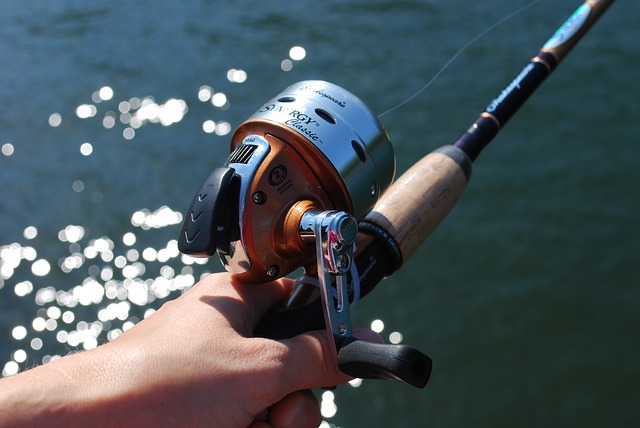
Rod & Reel
This is the most important piece of equipment that you can buy. This is your "weapon", so to speak. You need to take care of it and keep it in tip-top shape if you want it to be as effective as possible. Rod & reel sets are sold in several different ways. You can buy just the rod & reel, you can get the rod & reel separately, or you can buy a kit which usually includes the rod & reel, a tackle box, and some assorted equipment. For catching largemouth bass, I recommend that you buy a rod & reel already assembled. Usually, they even comes with fishing line already on the reel. Some of these rods can be very expensive. However, you can also find many exceptional fishing poles in the $20-$30 price range. This is your best option and it's what I'd recommend.
There are different types of rods and reels. You'll need a light to medium action rod about 5'-6' long. You should get a reel with an open face as opposed to a closed face. I prefer the open faced reel because you have more control in casting and they seem to tangle a lot less. However, it's really up to you. Also, make sure to get a pole that splits into two pieces. This makes it much easier to transport. I always keep my pole in the trunk of my car, for those long lunch breaks. I never pass up an opportunity to throw out a few casts!
Hooks
You'll need a few different kinds of hooks to fish for bass. First, you'll need hooks for your live bait. For this, I'd recommend buying #2 and #4 size snelled hooks. These hooks often come with about 6 inches of line already attached to them with a small loop on top. This makes them easy to tie onto your line. You'll also need some rubber worm hooks. Again, size 2 is perfect for this.
Floats or Bobbers
Floats are great for fishing with different types of live bait. They serve two major purposes. First, they allow you to suspend your live bait, such as nightcrawlers, at different levels beneath the water's surface. Second, they let you know when a fish has taken your bait and the fight is on. There are many types, such as "stick" shaped floats and "sphere", or round floats. I recommend picking up some round floats. Get the yellow & orange fluorescent type floats for the best visibility. They don't have to be very big, maybe 1 to 2 inches from the widest points. They sell many packs that come with a bunch of different sizes. That's probably your best bet.
Swivels
Swivels are brass attachment that you tie onto the end of your line. They have a clasp on the end that allows you to switch your lures on and off quickly. They are great because you don't have to cut and tie your line every time you want to switch lures. They usually come in packs of 12 and cost less than $1. These are a great tool and can save lots of time. They come shiny, black, or even red. I recommend the shinier ones, because they can attract bass.
Sinkers
Sinkers are used to weigh down your lure or line to make them swim at different levels below the surface. For bass fishing purposes, you'll need some smaller "split-shot" sinkers. They are usually attached to your line a few inches above your rubber worm to bring it deeper into the water as you reel it in. This works well when the bass have gone deeper in the water. They are circular and you crimp them onto your line using a pair of pliers.
Fishing Line
Some fishing poles come already set up with fishing line. However, I don't recommend you use the line that is on the reel. You have no idea how long it's been there, or even it's the right strength for catching bass. Fishing line comes in many different strengths, or "tests." If you are going after largemouth bass, you should use a line that is at least eight pound "test," meaning that it is strong enough to reel in an eight pound bass relatively easily. Also, you can look on the fishing pole right near where the reel is located and it will give you a recommended strength line for that particular rod & reel.
Tackle Box
Now that you've got everything you need, you'll need a place to store it. That's where your tackle box comes in. There are several size tackle boxes available. Some have one shelf and some have as many as ten. You'll have to decide what best fits your style. They even make tackle boxes with nylon carrying cases. I recommend a simple toolbox style with two shelves. That will hold just about everything you need to catch largemouth bass.
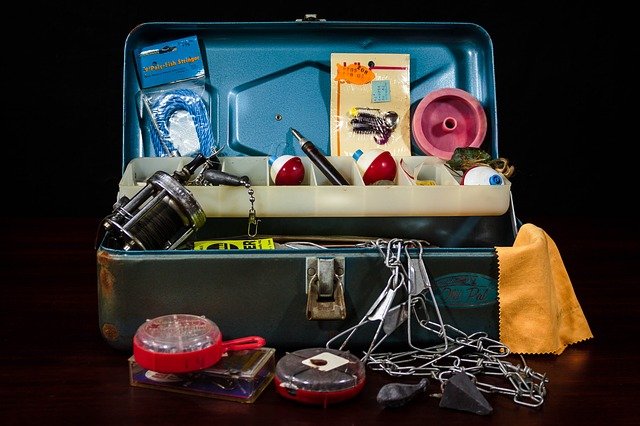
How To Set Up Your Fishing Pole For Bass
Here's a really great video that illustrates how to set up a fishing pole to catch bass, courtesy of YouTuber "trails". Make sure you head over to his channel and show him some love!
Largemouth Bass Baits
Now that you've got your fishing license and rod & reel, you'll need some specific bait is you want to catch largemouth bass. There are several baits that bass prefer more than other fish. They like their baits to look and smell as real as possible. Largemouth bass are finicky eaters. They are picky about what they strike, but if they see something they like - WHAM! It's all over! I'm going to detail a few of the most important baits below.
1. Live Baits
Live baits are probably the easiest type of bait to catch largemouth with. The reason is simple. It's the real thing. If you had a choice between a real apple and a plastic replica, which would you choose? It's not really that simple, fish can be fooled into believing that plastic baits are real, if they look real. The two best baits to catch largemouth on are minnows and nightcrawlers. There are other kinds of live baits, but these are the two most popular. They both have their own way of being fished. Nightcrawlers are generally fished using a #2 or #4 hook and suspended about two feet below the below the surface, using a float or "bobber". Minnows are fished by hooking them through their front lip while still alive. This is so that when they hit the water, they can still swim naturally and attract a hungry largemouth.
2. Plastics
There are many types of lures that fall into the plastics category, but in in terms of largemouth bass, I'm referring to rubber worms, frogs, lizards, and leeches. Bass love rubber worms. When you go shopping for your bait, you'll see that there are literally hundreds of different kinds. I recommend finding brightly colored worms, either 5" or 6", if you want to catch largemouth bass. You can also find worms that already have the hooks in them, and yet others that are set up to be "weedless".
Other type of plastic lures are the plastic minnow, jitterbugs, hulapoppers, and rattling lures. They come in many sizes and shapes, and all are great for bass fishing. These lures also come in different weights, and I'd recommend that you pick up 1/8 to 1/2 oz. sizes for your purpose. There are many color variations, and light, shiny colors usually work well for bass. These lures can cost anywhere from $3 - $15, depending on size and brand.
3. Spinnerbaits
Spinnerbaits are a combination of hook, plastic spoon, jighead, and some plastic tassels. they resemble a small fish or insect to the bass and the bass just love them. As they move through the water, the metal spoon spins and creates noise underwater that make the bass crazy. These come in all colors and sizes, but I recommend 1/4 to 1/2 oz. spinner for catching largemouth bass.
4. Spoons
Fishing spoons are called spoons because that's what they closely resemble. They look like small, shiny spoons with three hooks attached on the end. These are great for catching bass because of their shiny appearance and movement through the water. When fished right, they resemble a distressed minnow. They come in many colors. Some are red & white, some have spots, and some are fluorescent. they also come in lots of sizes. I recommend a 1/4 oz. or a 1/8 oz. to catch bass.
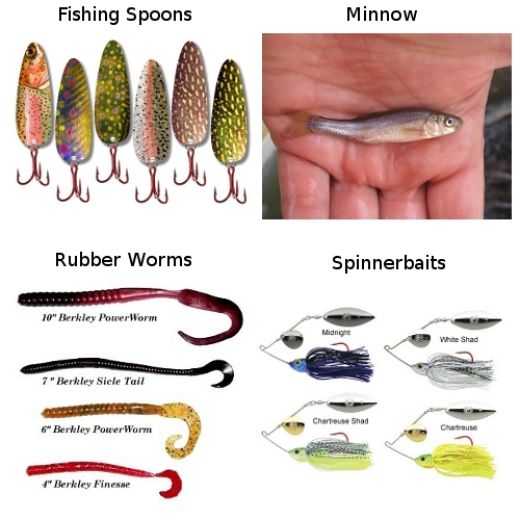
How To Choose The Right Bait For Bass
How To Catch Bass With A Rubber Worm
The Best Places To Fish For Bass
Largemouth bass are generally found in shallow waters. The are warm water fish and when the weather is colder, they will move deeper to be in the warmer water. When the temperature rises, you'll find them in shallow waters closer to shore.
One of the things that makes largemouth bass fishing so popular is that you don't need a boat to fish for them. You have just as good a chance off landing a lunker from the shoreline as you do in a boat. I've listed a few places that you should concentrate on more than others.
Overhanging Trees And Weedy Shorelines
Bass are often found close to shore. A great place to cast is underneath trees that hang into the water and areas where there is a lot of growth next to the shoreline and in the water. You need to be extra careful not to get snagged and tangled as you fish these areas. A weedless plastic worm works great.
Docks & Pylons
Bass seem to congregate underneath docks and pylons that are left underwater. Remnants of an old dock where all that's left are the posts and pylons are great places to cast. Fish a little deeper in these areas and "jig" your bait up and down nest to the dock posts for best results.
Lily Pads & Reeds
Areas where there are dense weeds and lily pads are usually loaded with largemouth bass. A weedless plastic frog work great in these situations. Fish it really slow, and make it "hop" up and down by jerking your rod lightly as you reel it in.
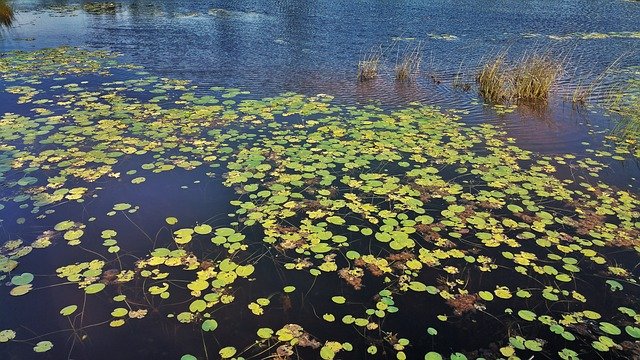
Rock Beds And Stone Formations
Rock beds and remnants of old stone walls are great places for bass to be. They are great places for bass to nest and lay eggs. If you can find a stone wall or rock bed, cast your line out and reel it in slow 6-8 inches above the rock bed.
Islands
Sometimes these aren't easily accessible from the shoreline, but if you can get close, try to fish the banks of the island. Bass often congregate around the under structure of the island and beneath overhanging trees and weeds. Fish a weedless worm or plastic frog slow about 1-2 feet below the surface. Jerk your pole occasionally to give the bait a twitching motion as you slowly reel in.
Some Expert Tips To Catch Largemouth Bass
Well, I hoped that helps you out if you are thinking of getting into freshwater bash fishing. I've been doing it for a LONG time, and it's one of my favorite hobbies. I NEVER get bored, and every time I hook a "lunker" (angler talk for a big bass) it's just as exhilarating as my very first catch!
Also, I want to take a moment to thank YouTuber "trails" for the awesome videos he puts up about catching bass. If you've got a minute, check his channel out and show him some love.
Here's the link: https://www.youtube.com/channel/UCRVB6PjJ2_nr-hY10ue-_nw
I'd like to thank you guys for taking the time to read my post, and I hope it's been helpful. If you would be so kind, I would love an upvote, follow, resteem... Well, you know the deal! Thanks guys and gals! Until next time.
I'll leave you with this sweet image of a gorgeous bass "taking the bait!"
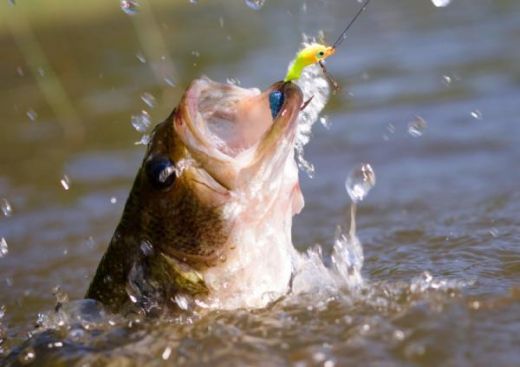

I like your story and fishing hobby. What is your biggest size of fish!
Thanks! My biggest largemouth bass catch has been 17 pounds. Caught at Keech Pond in the summer of 2005.
Try always, throw your line; where you least think about it, you may take a fish.
German proverb
That's a very wise proverb. I will definitely keep that in mind next time I'm out on the lake!
I have been fishing for bass for more than 20 years…
I was going to ask if you thought eating fresh water was healthy; and, came up with my own conclusion on learning how long you’ve fished this way.
I love fish; and, can say, the pictures reminded me that ‘I have a yen for fish for dinner’…lol…
Most research shows wild-catch to be the healthiest.
Is there a way to test the fish to see if it’s got too many toxins? Or is there a way, when gutting the fish to know if it’s not healthy?
Have you ever gone on fishing jaunts in deep-sea waters? If so, and as time permits, this experience would make an insightful post.
Thanks for sharing this very detailed post. It should be helpful for anyone wanting to gift someone with an essentials tackle box, or take up the productive hobby of fishing.
Peace.
Thanks for commenting. I am a strictly "catch and release" angler. In the 20+ years I've been freshwater fishing, I have never eaten any of the fish I catch.
I guess that doesn't make me very qualified to answer your first question. However, I think it depends on the waters that you are fishing when it comes to eating your catch. Also, I know there are tester kits available to test mercury levels in the water. I don't think there is any way to test the fish on site. It would probably need to be lab tested.
It's important to mention that I do eat bass, tilapia, trout, and catfish, but I usually buy it at the market or order it at a restaurant.
I've never been salt water, or deep sea fishing, although it's on my list of things to do soon.
I lived out in the "country" for the first 35 years of my life, so I had access to a ton of freshwater lakes, ponds, and rivers. However, most of the big catches I've gotten came out of private fishing holes. I have several friends that own large parcels of land with their own man-made ponds, stocked and all.
Since I moved to Arizona in 2007, I haven't been fishing nearly as much as when I lived in Rhode Island. My family also used to own a summer home on a large lake, so growing up there was lots of good times.
Thanks for your reply!
it's on my list of things to do soon
Godspeed on your deep-sea fishing adventure!
Peace.
I've been fishing black bass in Italy since 10 years, I love the thrill of the catch! Nice tips and tricks, next time I'll try to use live baits, always fished with plastic worms till now.